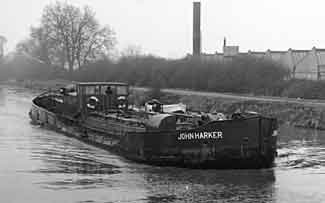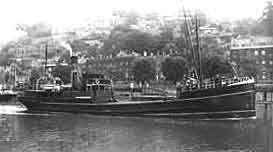Ron Abbotts
I
first had regular contact with the canal from September 1939 when
the pupils of my school in Birmingham were evacuated to Gloucester
to share the old building of the Crypt School (a scheme which lasted
for a mere twelve months). During my time with a family in Tredworth,
I would cycle regularly down the tow path to Fretherne Bridge near
where three households of my father's family lived. Subsequently
I paid many more visits to the area during the 1940s. When we first
arrived, we evacuees were encouraged to get to know Gloucester.
Two of the "treats" we were given were a conducted tour
of the gas works just south of Hempsted Bridge and a look over Salamander,
the fire tder, at her berth at the south end of the docks.
 Tanker Barges Tanker Barges
I would spend quite
a few hours at the canal side watching the heavy wartime traffic,
particularly the Hull registered John Harker oil barges which would
ply the route in the form of a motor powered lighter usually pulling
a second craft. I gathered that the north end of their journey would
be the oil depot at Stourport on Severn. Two workings would often
operate with very little space between them, sometimes sharing only
one passman who cycled along the towpath to help open and close
the bridges. Having seen the northbound fourth craft safely through
Fretherne Bridge, he would have to pedal like fury to Sandfield
Bridge so that he could open his half of the bridge to enable the
leading pair of barges an uninterrupted trip on through to Saul
Junction.
Ships
An
impressive ship to be seen from time to time on the canal in those
days was the Ben Robinson, a coaster from the old Ben Line,
regarded by the locals as the biggest ship that could make it to
Gloucester. I seem to remember, too, at least one occasion when
an RN submarine was taken up to Gloucester to assist in the promotion
of the War Savings campaign.
Hempsted Dry Dock
Cycling
down the towpath below Hempsted Bridge, I looked across to the small
dry dock at right angles to Bristol Road opposite the gas works.
High and dry there in September 1939 was Hurley, a steam
powered pleasure boat owned by Grove & Sons of Evesham and used
for trips along the Avon to Chadbury and Fladbury. I had been given
a number of trips on her as a child and was surprised to see that
she had managed to reach Gloucester, given what was then the horrendous
and barely navigable state of the Warwickshire Avon in its last
few miles to Tewkesbury.
Two Mile Bend
At
Two Mile Bend, I can remember looking across from the towpath to
the lagoon on the other side where there were floating raw material
log stocks for the Moreland's match factory.
Mud Distribution
Between
Castle Bridge and Saul Junction, a hazard for cyclists on the towpath
was a large structure spanning the path. This equipment took up
canal bed mud raised by the dredger and conveyed it overhead by
bucket chain to the low lying fields on the west side. I endured
a few interesting mud splatters whilst peaceably cycling underneath.
Sandfield Wharf
Not
long after the attack on Pearl Harbor, the US Army began to arrive
in the UK in some strength, at which point two large warehouses
were put up adjoining Sandfield Bridge, to be occupied by a unit
of US army supply troops. I cannot recall any canal traffic mooring
at the unit as most of the movements in and out of the site were
by heavy army trucks which came and went via the Perry Way. The
warehouses were manned by a small contingent of black soldiers at
a time when the US army observed strict colour segregation. This
afforded a slight cultural shock to the local community, and led
to a modest but eye-raising amount of fraternisation between the
troops and some local young ladies in Saul.
Fretherne Bridge
An
interesting feature at Fretherne was the steel pontoon which was
moored just south of the bridge on the Frampton side. This was used
as a float-under support to the bridge when any heavy vehicles or
equipment (e.g. telegraph poles) had to be moved across for Arlingham
or anywhere westward towards the river.
Chris George Recalls a Scout Camp
I
was a member of the 2nd City of Gloucester Sea Scouts from 1941
to 1946. In 1942, we acquired a campsite on the east bank of the
canal, north of Sellars Bridge just on the Stonebench Turn. It consisted
of Canal Company land between the farm hedge and the canal where
we set up tents, and our scout master Ken White later brought his
caravan. We held our first camp there over Easter 1942. It was cold,
wet and for me (aged 12) a big adventure. During the following summers,
we spent much time there. We had our boat; a 15ft open yawl; in
which we learnt the rudiments of sailing, pulling, and most useful
of all, sculling over the stern with one oar. To go afloat, we all
had to pass a swimming test clad in shirt and shorts - across the
canal and back, about 50 yds. Several of us built the "Boy
Scout Association Kayak" design advertised at that time. I
think we had two or three of them. In 1943, a dumb barge had sunk
off the campsite, and the hulk had been dragged against the bank
on our side. I believe we eventually removed the name board and
the handsome wooden ship’s wheel, and a hut was built using timber
"salvaged" from the wreck.
Rex Potter Also Recalls the Scout Camp
I
was a very keen member of the 2nd Gloucester City Sea Scouts
from 1941 to 1947. One night, we were camped in a tent on the
bank of the canal when the sirens sounded and we could hear
the planes going overhead. We could see the bright powerful
searchlights lighting up the sky and hear the distant sound
of the anti-aircraft guns. The next morning we had breakfast
of baked beans heated in a frying pan over a wood fire. We used
a forked stick to suspend the billycan to heat the water for
our cocoa. Unfortunately, our meal was spoilt due to earwigs
falling out of the forked stick into the frying pan.
After
a barge was sunk in the canal near our camp-site, the army set
a number of explosive charges, blowing up the wreck to
clear the way for water traffic. It was thrilling for me
as a young boy to see how high the water shot up into the air.
I was saddened to see how many fish were killed, reinforcing
what I knew was happening all through the British Isles and
around the world due to the war. I knew that through seeing
all the newspapers in our family's newsagents shop in Southgate
St. Chris George and I salvaged the timber from the barge in
the intervals between the laying of explosive charges, using
the scout 15 foot yawl to tow the timber ashore. The salvaged
timber was later used for building a scout hut to accommodate
our kayaks. We also used it as accommodation a few times, sleeping
in our home made hammocks. From memory the hut was approximately
20 feet long by about 6 feet high and 8 feet wide. I also used
some of the timber to build a punt, caulking it with oakum and
sealing it with tar melted over an open wood fire in a paint
pot. It was not very successful, being too narrow, and was very
heavy. I moored it in a small bay, but when I came back a week
later, it had been swamped by passing traffic and was full of
water.
During the War, a Sea
Scout Jamboree was held in Gloucester, scouts coming from all
over England, with events centering on the docks. It was great
fun. Scouts were accommodated in a hall in Southgate Street,
which was used as a war time cafeteria. We slept in sleeping
bags on the floor. Some kayak & canoe races were held in
the docks. Chris George and I paired up in his canoe, and we
won a race.
 Ken Hughes Recalls the Perils
of War Ken Hughes Recalls the Perils
of War
My
father was captain of the SS Pamela which left Sharpness
on 10 Oct 1944 bound for Liverpool with a load of barley. The ship
never arrived at her destination and was declared lost at sea with
all hands. I have recently found that she was built in 1921 and
registered at Beaumaris as 403 tons gross. Her original duty was
the transport of slate mined in the hills behind Bangor, but later
she became a general cargo vessel. After her loss, a court of inquiry
concluded that she had probably struck a mine. In the late 1990s,
her wreck was discovered by divers sitting upright at a depth of
about 50m with a hole in her starboard side. In spite of what happened
to my father, I also chose a life at sea and, by a remarkable coincidence,
started on the training ship Vindicatrix at Sharpness on
the same day in 1957 as my father had left there in 1944.
Ken McTigue Recalls a Ship Aground
While
I was a trainee deck boy on board the Vindicatrix in October
1948, a Greek ship ran aground while trying to enter Sharpness.
A hawser had been passed from the ship to the jetty, but as the
winches took up the strain to haul her in, the hawser parted and
the wind and tide carried the vessel up into shallower water. There
was a raging storm at that time with lashings of rain, and the tugs
that were there were unable to pull her off the shallows. The next
day, larger tugs were brought up the river, and as far as I can
remember she was floated off successfully and taken into the tidal
basin. I know that she was taken into the docks and discharged her
cargo because I was allowed to work on the docks during my last
weeks on the Vindicatrix, and I went on board and bought cigarettes
from the crew.
Dave Crowhurst Remembers Fishing in the 1950s
Reading
the above memories reminded me of fishing in Gloucester Docks when I was a boy in the 1950's.
It was a popular place to fish for us boys because of all the
wheat overspill that fell from the quayside into the water near
Llanthony Bridge. It attracted many small dace and other fish near the
wall and made for easy fishing. I recall on one
occasion that a midget submarine was diving and surfacing in the
docks. It caused huge excitement and a very large crowd of onlookers. |
 Tanker Barges
Tanker Barges Ken Hughes Recalls the Perils
of War
Ken Hughes Recalls the Perils
of War